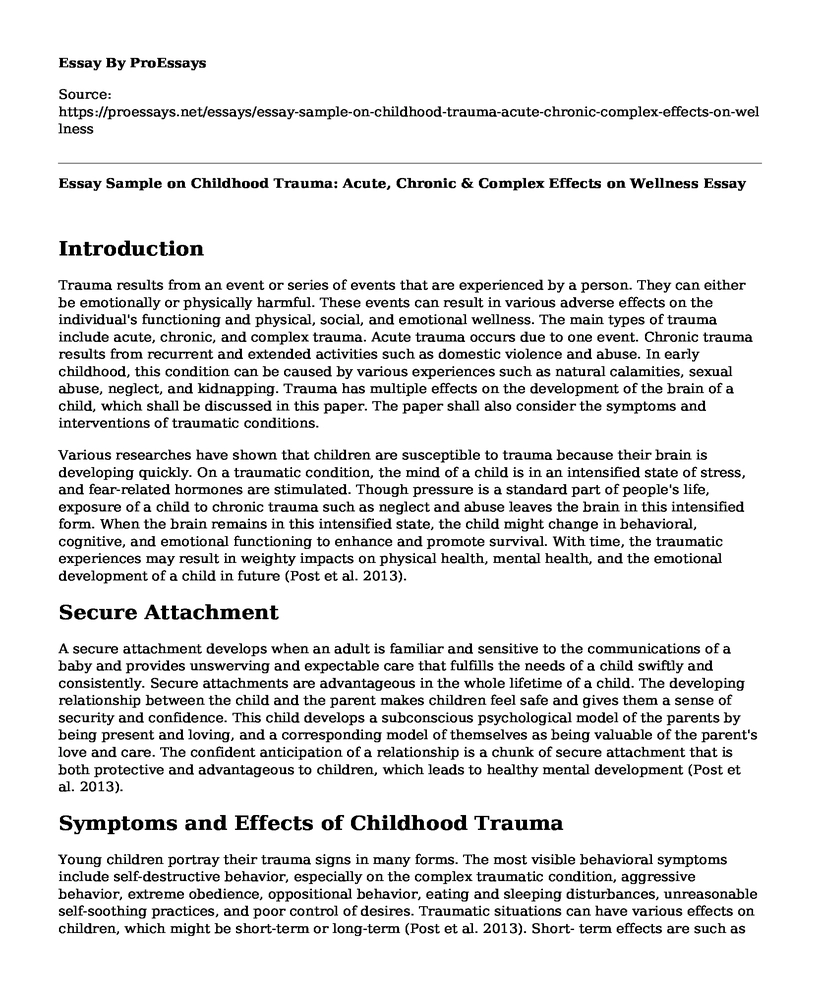Introduction
Trauma results from an event or series of events that are experienced by a person. They can either be emotionally or physically harmful. These events can result in various adverse effects on the individual's functioning and physical, social, and emotional wellness. The main types of trauma include acute, chronic, and complex trauma. Acute trauma occurs due to one event. Chronic trauma results from recurrent and extended activities such as domestic violence and abuse. In early childhood, this condition can be caused by various experiences such as natural calamities, sexual abuse, neglect, and kidnapping. Trauma has multiple effects on the development of the brain of a child, which shall be discussed in this paper. The paper shall also consider the symptoms and interventions of traumatic conditions.
Various researches have shown that children are susceptible to trauma because their brain is developing quickly. On a traumatic condition, the mind of a child is in an intensified state of stress, and fear-related hormones are stimulated. Though pressure is a standard part of people's life, exposure of a child to chronic trauma such as neglect and abuse leaves the brain in this intensified form. When the brain remains in this intensified state, the child might change in behavioral, cognitive, and emotional functioning to enhance and promote survival. With time, the traumatic experiences may result in weighty impacts on physical health, mental health, and the emotional development of a child in future (Post et al. 2013).
Secure Attachment
A secure attachment develops when an adult is familiar and sensitive to the communications of a baby and provides unswerving and expectable care that fulfills the needs of a child swiftly and consistently. Secure attachments are advantageous in the whole lifetime of a child. The developing relationship between the child and the parent makes children feel safe and gives them a sense of security and confidence. This child develops a subconscious psychological model of the parents by being present and loving, and a corresponding model of themselves as being valuable of the parent's love and care. The confident anticipation of a relationship is a chunk of secure attachment that is both protective and advantageous to children, which leads to healthy mental development (Post et al. 2013).
Symptoms and Effects of Childhood Trauma
Young children portray their trauma signs in many forms. The most visible behavioral symptoms include self-destructive behavior, especially on the complex traumatic condition, aggressive behavior, extreme obedience, oppositional behavior, eating and sleeping disturbances, unreasonable self-soothing practices, and poor control of desires. Traumatic situations can have various effects on children, which might be short-term or long-term (Post et al. 2013). Short- term effects are such as mood disorders which turns to long-term if they last longer than a few weeks.
Interventions Used for Traumatized Children
The interventions used on trauma are either preventive or treatment of traumatic stress. The methods of interventions used can be psychotherapy, pharmacotherapy, alternative therapies, and complementary interventions, among other therapies such as a combination of treatments (Post et al. 2013). Psychotherapy interventions such as teaching relaxation skills, child-parent psychotherapy, and cognitive behavior therapy are effective in preventing traumatic stress after exposure to traumatic stress. Pharmacotherapy involves use of antidepressant drugs on children who have experienced acute trauma to prevent the development of post-traumatic stress disorder (PTSD). On a similar setting, opioid analgesic morphine has been proposed in the context of acute care to avoid PTSD. Complementary and other alternative interventions address the issue of a child's self-esteem and personal confidence, interpersonal effectiveness and communication, trust, limit settings, as well as group interrelation (Post et al. 2013). This form of intervention uses horse examples to embolden the identification and expression of feelings.
Working with children is a highly specific and multifaceted exercise. The knowledge of childhood trauma helps me to develop a critical judgment of children and youths on their behaviors. Having known that children can change their practices due to exposure to traumatic conditions, one can dig deeper to the cause of various actions expressed by children, and offer a relevant, yet a permanent solution. As a counselor with knowledge of trauma, I can identify traumatic conditions and use the right interventions to prevent further immoralities due to shock.
Conclusion
In conclusion, trauma affects the brain development of a child by creating an intensified stress state of mind that triggers hormones in the brain, which results in a change in cognitive, emotional and behavioral functioning. However, these conditions can be treated by use of the correct forms of intervention such as psychotherapy which involves methods such as training relaxation skills which are simple, yet effective.
References
Post, B., Perry, B., Siegel, D., & Glenn, M. (2013). Trauma, Brain & Relationship: Helping Children Heal. [Video]. Available at: https://www.youtube.com/watch?v=jYyEEMlMMb0.
Cite this page
Essay Sample on Childhood Trauma: Acute, Chronic & Complex Effects on Wellness. (2023, Jan 19). Retrieved from https://proessays.net/essays/essay-sample-on-childhood-trauma-acute-chronic-complex-effects-on-wellness
If you are the original author of this essay and no longer wish to have it published on the ProEssays website, please click below to request its removal:
- Global Happiness
- Should School Require Uniforms? - Essay Sample
- Essay on Teaching & Learning: Two Intertwined Processes for Effective Communication
- Diagnosing and Treating a Bipolar Client: A Case Study
- Essay Example on Depression: Overcoming with MI/CBT Strategies - A Medical Perspective
- Essay Sample on Overcoming Physical Disabilities: Borges' Perspective
- Research Paper Sample on PTSD: A Growing Challenge for U.S. Military Personnel







